 If you are going to cook homemade sausage or sausages in a natural casing of pork intestines, then in best case you will be able to buy already cleaned ones, and at home just rinse them additionally and soak them for an hour or two in water with the addition of vinegar or a solution baking soda to beat back characteristic odor and disinfect. If your intestines are not cleaned, it’s not difficult to clean, except for the first time, out of habit 🙂 We’ll warn you right away - pork intestines have a peculiar bad smell, which is firmly held on the skin of the hands when working with them. Therefore, gloves from the first minute of training with the guts 🙂 The rest is elementary. To get your bearings - when cooking sausage per kilogram of meat or liver, 2 meters of intestines are enough, but a small supply just in case does not hurt. Unpeeled pork intestines are matte opaque, have a pinkish tint and consist of three layers - an inner soft, fatty-mucous, so-called "epithelium", a middle one - thin and durable, which is used as a natural casing for sausages, and an outer one - dense, permeated blood vessels. Our task is to get rid of the outer and inner layers, scrape and wash the middle one we need from them.
If you are going to cook homemade sausage or sausages in a natural casing of pork intestines, then in best case you will be able to buy already cleaned ones, and at home just rinse them additionally and soak them for an hour or two in water with the addition of vinegar or a solution baking soda to beat back characteristic odor and disinfect. If your intestines are not cleaned, it’s not difficult to clean, except for the first time, out of habit 🙂 We’ll warn you right away - pork intestines have a peculiar bad smell, which is firmly held on the skin of the hands when working with them. Therefore, gloves from the first minute of training with the guts 🙂 The rest is elementary. To get your bearings - when cooking sausage per kilogram of meat or liver, 2 meters of intestines are enough, but a small supply just in case does not hurt. Unpeeled pork intestines are matte opaque, have a pinkish tint and consist of three layers - an inner soft, fatty-mucous, so-called "epithelium", a middle one - thin and durable, which is used as a natural casing for sausages, and an outer one - dense, permeated blood vessels. Our task is to get rid of the outer and inner layers, scrape and wash the middle one we need from them.
- To begin with, the intestines are washed (rinsed) in cold water and cut into pieces about a meter long. Longer ones are more difficult to clean, and filling is inconvenient.
- Usually, the intestines are immediately turned inside out for cleaning and soaked for 2-3 hours in a strong solution of salt and soda (2 tablespoons of both per liter of water). This is justified - in an alkaline environment, fat, which is abundant in the intestinal epithelium, softens and is easier to scrape off, and salt, in addition, inhibits pathogenic microorganisms.
- To turn the intestines out, it is enough to arm yourself with a long, not too sharp metal needle or a smooth wooden stick, pick up the edge of the intestine with it and stretch it through until the intestine turns out. Virtuosos manage to twist the intestines with a stream of running water launched into them. All this can be mastered, but, in truth, it is not very pleasant to come into contact with the "aromatic" epithelium, even with gloves, so we do it differently - initially we squeeze it out from the inside of the intestine, discard it, then we wash the intestines, and only after that we turn it out for final cleaning . In our opinion, it turns out no less qualitatively, and at the same time neatly.
- So, the intestines were soaked in the indicated solution. It is better to take an enameled or glass bowl for soaking - plastic will “smell” for a long time later. We take a tray, put it on it cutting board, choose a knife with a not too long, thick blade.
- We put the intestines one by one across the board and, starting from the end of the intestine, capturing a section equal to the width of the board along the length, we scrape off the epithelium from the inside of the intestine with moderate pressure with the back (blunt) side of the knife blade. It will fall out of the intestines in reddish mucous lumps onto a tray behind the board and, naturally, it will then need to be carefully thrown away. At the same time, the rough outer layer of the intestine will spontaneously separate and shrink, which we will also throw away. When scraping, we hold the knife at an angle, with a slope that is convenient for you.
- So, gradually moving the intestine to the middle of its length, we clean the first half, then turn it over with the other end and clean it in the same way - it’s more convenient in both directions, closer to the exit 🙂
- This is the initial cleanup. Now the intestines should be washed under running water, turned out and cleaned (scraped) again to the ideal - the intestines should become absolutely transparent, white, thin. If scraped thoroughly, additional cleaning may not be necessary.
- We rinse again under running water, pulling the intestines onto the tap like a hose - the intestines will fill with water, it will immediately become clear how well they are cleaned and whether holes have formed in them. If formed, it is better to cut the intestines in these places (they will still burst when cooking or baking sausage. It's okay - we will make some sausages shorter 🙂
- Before filling with minced meat, the intestines will have to be turned out again as it was, so that the sausage has a flat, smooth surface - the intestines are not too smooth from the inside, there are flagella and villi of the connective tissue.
- Cleaned and washed intestines are immediately used for making sausages or squeezed, sprinkled with salt and stored in the refrigerator. Washed and dried peeled intestines can be frozen and used as needed. After thawing, the elasticity of the intestines is somewhat worse, but not so much as to create problems when cooking sausages. You can store well-cleaned intestines for a long time - a year, or even several years.
There are other ways to clean the intestines, but in the end they all boil down to scraping the intestines with a knife or other devices, differing only in the method of softening the epithelium - it is practiced to pre-salt the intestines, soak them in concentrated soda or acetic solution etc. All this works. Big secret- if the intestines are not soaked or salted, they will still be cleaned 🙂 It is also true that soda well eliminates the unpleasant smell of the intestines. Oddly enough, vinegar also helps, especially when cleaning especially “fragrant” large intestines 🙂 Lamb and beef intestines are cleaned in the same way.
practiced interesting way“Washing” the intestines without scraping is when there are a lot of intestines, and it is not possible to scrape each individually - the intestines are sprinkled with a mixture of salt and flour and acid is added ( citric acid or vinegar). All this action is carried out in a large basin - they rub, wrinkle, “wash” the intestines like linen, turning them inside out and washing them several times in water. To be honest, I personally didn’t have to, and somehow I don’t regret it 🙂
Surely there are other ways - the resourcefulness of our compatriots, as you know, has no limits 🙂 Innovators and propagandists of high-speed cleaning methods suggest pulling the entire intestine onto a pipe or other cylindrical length of a suitable diameter and using all kinds of abrasives from kitchen sponge to massage bath mittens. Enjoy watching the video 🙂
Anyone who often makes homemade sausage knows that the most delicious sausage obtained in a natural casing, which is the usual pig intestines. You can buy them in the market or in the supermarket, or you can prepare for the future yourself. About how to do it right and will be discussed further.
First, let's prepare the intestines. It is worth noting that on home kitchen it is best to use pork intestines.
To begin with, we separate the intestines from the bladder and rectum. If this is not done, but immediately deal with the intestines, the contents of the bladder and rectum can hopelessly spoil finished product. Therefore, we immediately separate them from the intestines. To do this, the intestines are placed in a bowl so that part of it passes over the edge of the container, and the small intestines are separated, moving from the stomach to the intestines. At the same time, the contents of the intestines are squeezed out, and then, the small intestine is separated from the entire intestine. Further, they carry out along the intestine with a hand, separating fat from it. They lower the intestine into the water and divide it into several parts, so that it is more convenient to process it.

In the water, the intestines are again passed between the fingers, squeezing out the remnants of the contents from them. The water is drained, and the intestines are washed under running water, passing a stream of water through the hole.
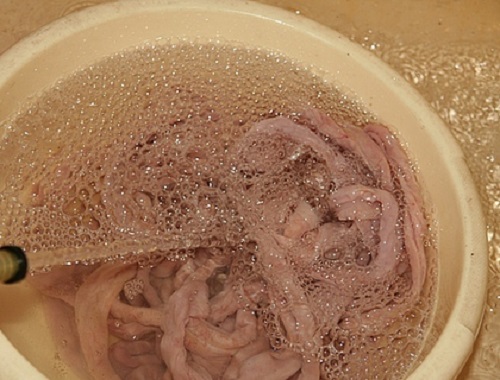
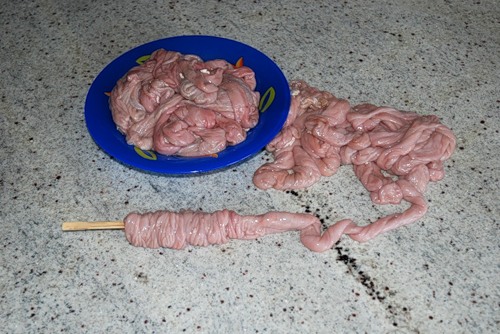
Then, we wash them in salt water, put them on a flat surface and gently scrape off the mucus with the blunt side of the knife, moving gently along the entire intestine.
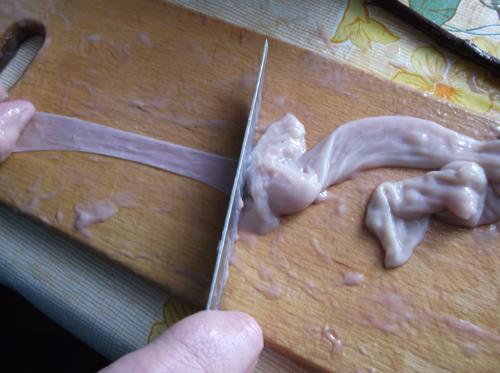
The colon is cleansed in exactly the same way. However, they have a folded structure. Therefore, it is much more difficult to wash and clean them. To clean the large intestines, they are cut into small pieces. In this form, the colons are easier to process and clean. The intestines cleared of mucus are poured clean water and start preparing minced sausage.
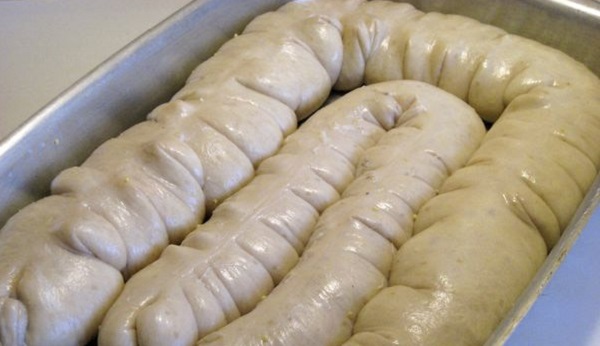
If the intestines will not be stuffed with minced meat in the near future, then they are harvested for future use, carefully tying in small bundles and pouring abundantly rock salt. Then, the intestines are placed in a container, from which the excess of the formed liquid must leave. For this, it is advisable to use a colander. If the fluid does not go away, the intestines may deteriorate.
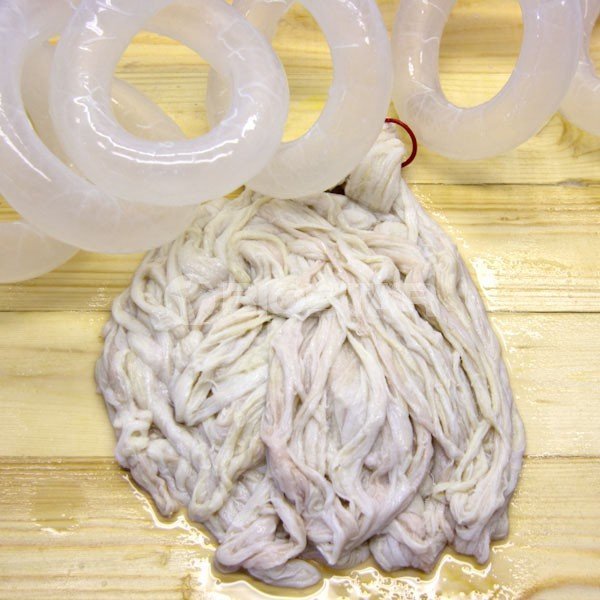
Faster and easy way how to prepare sausage intestines with two knitting needles, see the video from "Cooking Delicious at Home".
Training intestines
To prepare sausages at home, not only the small intestines are used, but also the stomach.
The intestines are processed immediately after the slaughter of the animal. First, the intestines are separated from the mesentery, which connects them into loops. To do this, the intestine is cut off from the stomach and with one hand they pull it by the end, and with the other they support the mesentery. The released intestines are placed in a basin with water.
The washed intestines are turned out and the mucous membrane is cleaned from them. To do this, the mucous membrane is first sprinkled with salt, and then scraped off with the blunt side of the knife, putting the intestine on a flat board.
The cleaned intestine is washed again cold water 2-2 times, and then with a weak solution of potassium permanganate (pink).
For boiled sausages the processing of the intestines ends here, and for raw smoked - the intestines are poured, i.e. placed in salt water, which is changed after 2 days, for 15-30 days.
When salting in a dry way, the intestines are placed in a bowl with holes at the bottom for draining the brine, sprinkled with plenty of salt and placed in a cool room.
Processed intestines can be dried by inflating them with air and tying the ends with threads. Dried intestines should be clear and thin. After drying, the air is released, the intestines are rolled up and stored in a dry, well-ventilated area.
Salted intestines are soaked in warm water few hours.
Dry intestines are soaked in cold water to make them elastic.
Cooking minced sausage
Sausage is prepared not only from pork, but also from the meat of other animal species. Meat can be used fresh, cooled, chilled, ice cream.
Pork meat is sorted by fat content, and then cut into pieces weighing 200-250 g and covered with salt and nitrate. For 10 kg of meat take 300 g of salt and 10 g of saltpeter.
Salted meat is placed in a cold place for 2-3 days, and then ground in a meat grinder 2-3 times until a homogeneous mass is obtained.
For boiled sausage for 3.5 kg of salted lean meat add 1 kg of semi-fat meat and 0.5 kg of finely chopped bacon, 200 g of starch, a teaspoon of sugar, a quarter of a teaspoon of black or red ground pepper, 1-2 large cloves of peeled garlic, 1 liter of cooled boiled water.
First, grind each type of meat separately, adding garlic to it.
Ready minced meat lean meat knead by adding about 0.5 l of boiled water (cold) to it. After the mass becomes homogeneous, fatty minced meat, pepper, starch are mixed into it, which are first diluted in cooled water. The mixture is stirred again, then finely chopped bacon is introduced into it.
It is impossible to mix the minced meat strongly, as this will lead to salting of the mass and the release of water from the finished sausage. Stirring of minced meat is completed after the bacon is evenly distributed in it.
As lean meat for sausage, you can use beef or lamb.
If you are planning to cook homemade sausage yourself, then you should think about which ones you will use.
Natural casings of cattle, pigs and sheep are, of course, best suited for this purpose.
Intestine sausage casings must be harvested, cleaned and processed immediately after the slaughter of animals, since if the processing process is delayed, the intestines lose their elasticity, strength and quickly deteriorate.
Let's first consider which intestines are suitable for making sausages, and then we will learn how to clean them, salt them for further storage and analyze in detail how to prepare intestines for homemade sausage.
From pig intestines, you can use everything: the stomach, small intestines, curly, rectum and bladder.
Intestines obtained from one pig can hold approximately 15–16 kg of minced meat. Pork small intestines can be used to cook all grilled sausages, sausages for frying,.
Thin pig intestines can be used to make some varieties of hot smoked sausages, as well as raw smoked ones.
The great advantage of pork intestines is that they can be processed without special training. In addition, pork intestines are edible, and this is important for grilled sausages.
It is best to use pig intestines with a diameter of 28–30 mm. For the preparation of thick hot-smoked, boiled and raw-smoked sausages, other sausage casings should be used.
From beef, you can use the small intestines (the so-called beef guts), the caecum (bruise), the colon and the bladder.
Of the lamb intestines, only the casings and the caecum can be used for stuffing minced sausage.
Intestine processing for homemade sausage
1 option. First of all, separate the intestines from the mesentery, which connects them into loops. To this end, cut off the intestine from the stomach and pull it by the end with one hand, while supporting the mesentery with the other hand. Fold the intestines freed in this way into a basin filled with water.
Then cut the intestines into pieces of 5-6 meters and squeeze out all the contents from them, passing between the fingers clenched into a fist. Next, rinse the intestines several times with cold water.
Carefully washed intestines turn inside out, then clean off the mucous membrane from them. To do this, first sprinkle the shell with salt, and then scrape it off with a knife (blunt side), placing the intestine on a flat board.
Rinse the intestine thus cleaned several times with cold water and finally treat with a weak solution of potassium permanganate.
If you plan to cook boiled sausage at home, then at this stage the processing of the intestines can be completed.
For raw smoked sausages the intestines still need to be poured, that is, placed in salt water for 2–4 weeks, changing it every 2 days.
In the process of dry salting, the intestines should be placed in a bowl with holes at the bottom so that the brine drains, sprinkle generously with salt and leave in a cool room.
Option 2. At the intestines, carefully separate the intestinal fat, squeeze out the contents and rinse the intestines thoroughly with running water. Then put them in a saucepan with water heated to 40-50 ° C, and soak in it for 4 hours.
To process the inner, mucous layer, turn the intestine inside out with a round stick and soak for 2 hours. Small intestines - in water heated to 50 ° C, thick - in water heated to 85–90 ° C.
Then, with a blunt knife, gently scrape off the mucous membrane. Rinse the cleaned intestines 2-3 more times with running water and the last time with water with the addition of potassium permanganate, painted in a pale pink color.
Intestinal fat can be washed and melted into food.
Turn the cleaned and washed intestines on the front side, cut into pieces convenient for stuffing with minced meat (30-35 cm each) and use for cooking sausages, after tying one end with twine.
If the intestines are not supposed to be used immediately, then they can either be salted or dried by hanging them on ropes.
When salting, rub the intestines thoroughly with salt, tie them, then put them in baskets, keeping them in them for 12–24 hours, so that they are salted and the brine stack, then put in a saucepan or tub, sprinkled with salt.
To dry, fill the pre-cleaned intestines and bladders with air (inflate with a straw or tube), tie and hang on clotheslines to dry.
The end of drying can be determined by appearance: the intestines should become transparent and rustle when touched. Free the dried intestines from the air, roll them up into a ball and store them away from moths.
Rinse salted intestines in warm water before using. They should be firm, light pink in color and have a specific smell characteristic of freshly salted meat.
Immediately before making sausages, soak the dried intestines in cold water for 2-3 hours to restore elasticity.
If it's supposed to store guts long time, they need to be washed, folded into glass jars, fill with saturated salt solution and close with polyethylene lids. Guts in brine can be stored for 5 years.

